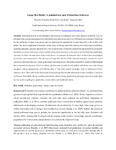Large Hive Beetle: A potential new pest of honeybees in Kenya

View/
Date
2018-04Author
Wambua, Benedict
Muli, Elliud
Kanui, Titus
Muli, Benjamin
Metadata
Show full item recordAbstract
Substantial decline in the abundance and diversity of pollinators have been reported worldwide. Loss of
pollinators has serious consequences for both biodiversity and crop productivity. Pollinators are essential or beneficial
for the production of many crop species and also important for reproduction of more than 65% of the world’s wild
plants. The drivers implicated in honeybee colony losses in Europe and North America have been reported in Kenya,
including pathogens, parasites and pesticides. The recent declines in honeybee populations and demand for sustainable
pollination to ensure food security have resulted in increased awareness of the need to protect honeybee populations
especially in Africa. In many areas of the world where it is managed, the honeybee (Apis mellifera) has been plagued
by diseases, pests and parasites. The presence of Large Hive Beetle (LHB) in Kenya honeybee colonies has raised
concern as affecting honeybee colony performance and productivity. On-going research is aimed at determining
their seasonal occurrence; effect on colony performance (comb, brood, pollen and nectar area and colony
weights); colony productivity and effectiveness of low-tech control strategies such as reduction of hive
entrance sizes. This will be the first report of heavy large hive beetle infestation in Apis mellifera scutellata
in Chawia Taita Hills, Kenya and the potential to affect colony productivity through interaction with other
factors such as pathogens, pesticides, varroa mites and nutritional stress.
